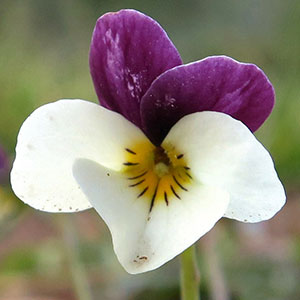Viola hallii
Viola adunca
Hall's violet, Oregon violet, wild pansy
Cascades early blue violet, common periwinkle, early blue violet, hook-spur violet, hookedspur violet, large periwinkle, sand violet, western dog violet, wild dog violet
1–3, decumbent or ascending to erect, ca. 1/2 subterranean, glabrous, clustered on single, short, vertical, deep-seated caudex.
1–5, erect, ascending, or decumbent, sometimes later reclining to nearly prostrate, glabrous or puberulent, on caudex from subligneous rhizome.
basal and cauline;
basal: 1–4, palmately compound, ± 2-ternate or 3-ternate, leaflets 3;
stipules adnate to petiole, forming 2 linear-lanceolate wings, unlobed, margins entire, apex of each wing free, acute;
petiole 5–8 cm, glabrous;
blade ovate to deltate, 2.8–6 × 2.6–6.5 cm, ± coriaceous, base tapered, ultimate lobes narrowly elliptic, lanceolate, or oblanceolate, 1–7 mm wide, margins entire, ciliate or eciliate, apex acute, mucronulate, surfaces glabrous;
cauline similar to basal except: stipules usually lanceolate, sometimes broadly ovate, ± leaflike, margins toothed;
petiole 1.3–6 cm;
blade 2–4.8 × 1.2–5.5 cm.
basal and cauline;
basal: 1–4;
stipules linear to linear-lanceolate, margins entire or laciniate with gland-tipped projections, apex acute to acuminate;
petiole 0.5–13.5 cm, glabrous or puberulent;
blade usually ovate or ovate-deltate to ovate-orbiculate, sometimes ± reniform or oblong, 0.5–6.9 × 0.4–5 cm, base cordate, subcordate, truncate, or attenuate, usually decurrent on petiole, margins crenate to crenulate or entire, ciliate or eciliate, apex acute to obtuse, surfaces glabrous or sparsely to densely puberulent;
cauline similar to basal except: stipule margins lacerate to laciniate;
petiole 0.5–6.5 cm;
blade 0.6–5.5 × 0.4–4.7 cm.
2.5–11 cm, glabrous.
1.7–13.8 cm, glabrous or puberulent.
sepals lanceolate to ovate, margins ciliate, auricles 0.5–1 mm;
petals: upper 2 almost black abaxially, dark reddish violet adaxially, lower 3 pale yellow, cream, or ± white, lateral 2 bearded, with deep yellow to orange patch basally, dark reddish violet-veined, lowest with deep yellow to orange patch basally, dark reddish violet-veined, 5–18 mm, spur yellow, gibbous, 0.5–2 mm;
style head bearded; cleistogamous flowers absent.
sepals lanceolate, margins ciliate or eciliate, auricles not enlarged in fruit, 0.5–2 mm;
petals light- to deep- to lavender-violet on both surfaces, rarely white, lower 3 usually white basally, dark violet-veined, lateral 2 (and sometimes upper 2) bearded, lowest 7–17(–23) mm, spur purple to violet or white, elongated, 5–7 mm, tip straight or pointed, curved up or lateral;
style head sparsely to densely bearded, sometimes beardless; cleistogamous flowers axillary.
ellipsoid, 4–12 mm, glabrous.
short-ovoid, 6–11 mm, glabrous.
light brown, shiny, 3.2–3.5 mm.
dark brown to olive-black, 1.5–2 mm.
= 60, 72.
Viola hallii
Viola adunca
Viola hallii was discovered on the grounds of Willamette University in Salem, Oregon, by Elihu Hall, a professor at that institution (V. B. Baird 1942). Leaves of V. hallii are similar to V. beckwithii.
(Discussion copyrighted by Flora of North America; reprinted with permission.)
Varieties 2 (2 in the flora).
Viola adunca is polymorphic with over 50 named taxa. G. D. McPherson and J. G. Packer (1974) reported that diploid, triploid, and tetraploid races of V. adunca occur in Canada and northwestern United States. They found that diploid and tetraploid chromosome races can be distinguished morphologically based on style beards and on the size of guard cells and pollen grains and recommended taxonomic recognition of both races. In diploid races, the style projections are more or less cylindrical and about one-sixth the width of the style; in tetraploid races they are short-conical or globular, and about one-tenth or less than the width of the style beard.
(Discussion copyrighted by Flora of North America; reprinted with permission.)
1. Plants (4–)4.5–30(–35) cm; basal blades 1.3–6.9 × 1.2–5 cm; peduncles 3–13.8 cm; 0–3600 m; widespread in North America. | var. adunca |
1. Plants 1.8–4.5(–6.5) cm; basal blades 0.5–1.7 × 0.4–1.4 cm; peduncles 1.7–5 cm; 2500–3800 m; restricted to Rocky Mountains (Colorado, Montana, Wyoming, British Columbia). | var. bellidifolia |
- Local floras:
BC,
OR,
WA
- Local Web sites:
CalFlora,
CalPhotos,
Flora NW,
Go Botany,
MI Flora,
MN Wildflowers,
PNW Herbaria,
Turner Photog.
WildflowerSearch
iNaturalist (observations)
USDA Plants Database
- LBJ Wildflower Center
- SEINet
- Plants of the World Online
- Encyclopedia of Life
- Wikipedia
- Google Image Search


